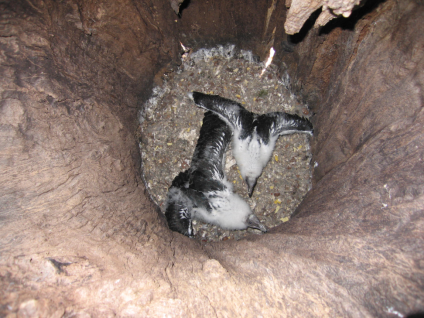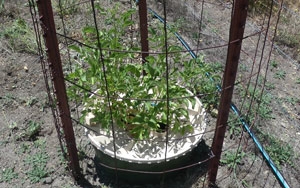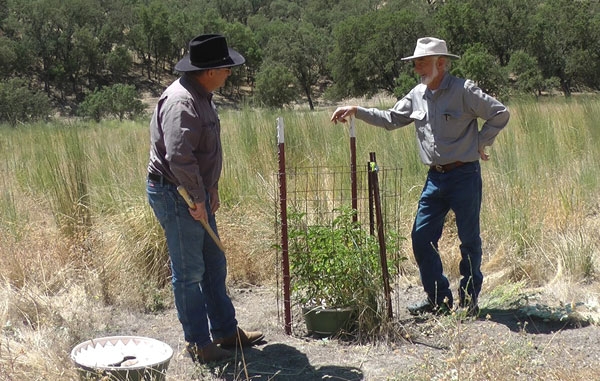Posts Tagged: oak woodland
California Assembly approved bill to protect oak woodlands
The California State Assembly passed a bill unanimously that would provide new resources to landowners to halt the encroachment of conifers on oak woodland, reported Hunter Cresswell in the Times-Standard. The bill (AB 1958) must be approved by the State Senate and Gov. Brown before it becomes law.
Oak woodlands are "some of the most biodiverse ecosystems in the North West," said UC Cooperative Extension forest advisor Yana Valochovic. "They are preferentially used by a lot of different bird species."
In the past, fires would burn out conifers and underbrush on oak woodland annually, but aggressive fire suppression is enabling them to spread unchecked, crowding out oaks.
Yanachovic is finishing a three-year research project on conifer encroachment, and AB 1958, if passed, would put policies in place so people can get rid of the conifers without jumping through as many bureaucratic hoops as before, the article said.
“It clarifies that the cutting of younger conifers out of oak woodlands does not qualify as conversion of timberlands,” she said.
Turkey vultures have peculiar nesting habits, study finds
Omnipresent and homely, turkey vultures are a native California wildlife species that doesn't get a lot of research attention.
But UC Cooperative Extension advisor Greg Giusti has found a surprising level of interest from the public in his Northern California research project about turkey vultures' nesting preferences in oak woodland.
“Animals with cute fuzzy faces are far more attractive in our culture,” said Giusti, a wildland ecology expert. “Turkey vultures have been overlooked. Very little is known about their biology and environmental needs.”
Giusti worked with Robert Keiffer, superintendent of the 5,300-acre UC Hopland Research and Extension Center in Mendocino County, to better understand the nesting habits of the red-faced scavengers.
In the study area, the researchers counted 417 trees in all; seven of them had suitable nesting elements for turkey vultures. They found that the vultures at the Hopland facility select large hollow trees – either dead or alive, either shaded or in the sun – to lay eggs and rear their young. The tree species in the study included blue oak, interior live oak, Oregon white oak and valley oak.
The nesting trees were widely dispersed and ranged in diameter from 36 inches to 65 inches around at breast height. The nesting cavities are vertical tubes in the tree trunks that drop down as much as 13 feet from the entrance to the ground.
“This is very different from other large birds, like eagles and osprey, who build open cup nests high up in tall trees, which they may use for generations,” Giusti said.
After turkey vulture chicks hatch, the parents drop into the cavity five or six times a day to feed their young, Giusti said. How birds with a five-foot wingspan traverse a deep vertical tunnel is a mystery.
“They just shimmy up and down, I would imagine,” Giusti said. “We don't know how the young birds do it when they fledge. We've never witnessed the adult birds calling them out.”
Giusti said the scientists will continue to build on the turkey vulture nesting database they have started with results from this project. In the coming years, they hope to learn whether turkey vultures will re-use successful nesting sites and whether they may be found nesting in fallen logs or rock piles.
In the video clip below, a turkey vulture explores a possible nesting cavity at the UC Hopland REC.
An initiative to maintain and enhance sustainable natural ecosystems is part of the UC Division of Agriculture and Natural Resources Strategic Vision 2025.
Oak preservation education comes to the foothills
Oaks (Quercus ssp.) are one of the signature trees of California landscapes and are among the most favored by wildlife, according to the UC publication Wildlife among the Oaks.
In addition, several studies have found that open space and residential properties containing oak trees have higher property values than those areas without oak trees. Ecosystem services provided by oak forests and savannahs include recreational opportunities, shade and shelter, increased property values, aesthetic values, erosion control, air and water filtration, and food and fuel.
However, the threats to oaks are many:
- Construction removes entire trees or damages the root zone resulting in oak tree death
- Subdivision of property and fragmentation in land use reduces open space for oak savannah and forest, threatening seedling recruitment in some oak species
- Inappropriate landscaping practices, designed to support exotic landscape species, threaten oak health
To ease the impacts of these threats, UC Cooperative Extension Central Sierra will bring oak education to five counties in the Sierra Nevada foothills – Amador, Calaveras, El Dorado, Mariposa, and Tuolumne. Public meetings and multiple-session training seminars will help educate land owners, policy makers and Master Gardeners in ways to protect, enhance and regenerate natural oak woodlands. Training will also provide information that Master Gardeners can disseminate to their clientele to help home owners protect landscape oaks.
The program is funded with a grant from Renewable Resources Extension Act (RREA), a USDA-administered program that serves to sustain the nation's forest and rangeland resources for future generations. According to the USDA National Institute of Food and Agriculture website, “RREA serves a broad array of forest and rangeland stakeholders, including landowners and managers, natural resource professionals, forest products industry, range-based cattle industry, and non-consumptive.” Recognizing that, as the website notes, “the sustainability of the nation's forest and rangeland resources is largely dependent on the actions of millions of private forest owners, farmers, ranchers, and land managers,” this series of educational workshops will focus on providing information to a broad audience.
In Tuolumne County on May 13, the Biological Resources Review Guide Ad Hoc Committee of the Board of Supervisors will meet to discuss various county policy options regarding oak mitigation. Richard Standiford, UCCE specialist in the Department of Environmental Science, Policy and Management at UC Berkeley, will address the committee, presenting his research related to oaks and property values. He will also provide information regarding mitigation policies.
On May 9, the Calaveras County Master Gardeners will receive the first session of an oak ecology, identification and landscaping practices workshop. They will identify oaks in the field, inspect trees damaged by construction and look for evidence of insect and other wildlife interactions. This will be followed by an interactive discussion exercise about how (or why not) to landscape around oaks. Standiford will visit the foothills at a later date to present oak ecology information to Master Gardeners.
UCCE studies a Dutch invention for regenerating trees and shrubs on oak woodland
For more than 100 years, Californians have been concerned about inadequate regeneration of trees and shrubs on oak woodlands. Firewood harvesting, agricultural conversions and intensive grazing threaten to convert woodlands into shrub fields or bare pastures.
The beauty of rolling hills studded with majestic oaks, other trees and shrubbery isn't the only reason to regenerate vegetation. The trees and shrubs create a much more hospitable habitat for a wide assortment of wildlife. Oak woodland vegetation also protects the quality of California water. The majority of the state's water flows through oak woodlands in streams and rivers that support fisheries, farms and cities. Plants and trees anchor the soil, preventing erosion and stream sedimentation.
One of the difficulties ranchers face in regenerating trees is supplying water for seedling establishment. Ranches often stretch for thousands of acres. Hauling water to remote sites or installing irrigation can be prohibitively expensive.
Third-generation San Miguel rancher George Work heard about a new tree establishment invention from Holland – a Groasis Waterboxx. Over the years, Work has collaborated with UC Cooperative Extension on oak planting projects and consulted with UCCE experts about squirrel diseases, ranch animal vaccinations and pasture management. He turned to UCCE natural resources advisor Royce Larsen for his thoughts on the Waterboxx.
“Because of Royce here, our Cooperative Extension agent, he provided a little added incentive when I wanted to try this thing,” Work said. “Royce said, ‘I'll help you.' Well, that was enough to get the job done.”
Work, Larsen and UC Cooperative Extension natural resources specialist Bill Tietje installed 10 Waterboxxes, which cost about $30 each, in a remote area of the 12,000-acre Work Ranch in southern Monterey County. Other plant regeneration methods – including traditional drip irrigation and tree teepees – were also installed for comparison.
The Waterboxx is a round plastic hat box-shaped reservoir that fits around the seedling trunk. When the seedling is planted, the reservoir is filled with about four gallons of water. A rope on the bottom continuously wicks moisture to the plant roots.
The box is covered with an inward-slanting corrugated top that cools during the night and channels condensed dew and fog into the reservoir, keeping it full of water. The Waterboxx provides a protective barrier around the trunk and shades and cools the soil beneath. At the Work Ranch, the plants are also enclosed in bale-wire fence to keep out wildlife poking around for water or hungry for tender green growth.
“The trees are doing surprisingly well," Larsen said. "In just three months, the seedlings have grown more than two feet."
Larsen said he will continue monitoring the project to see if the self-watering system can establish trees. If successful, UC scientists may study the Waterboxx more thoroughly in a replicated research design in Monterey County, San Luis Obispo County and other parts of the state.
See the components of a Waterboxx in the video clip below.
Read a transcript of the video.
Waterboxx






